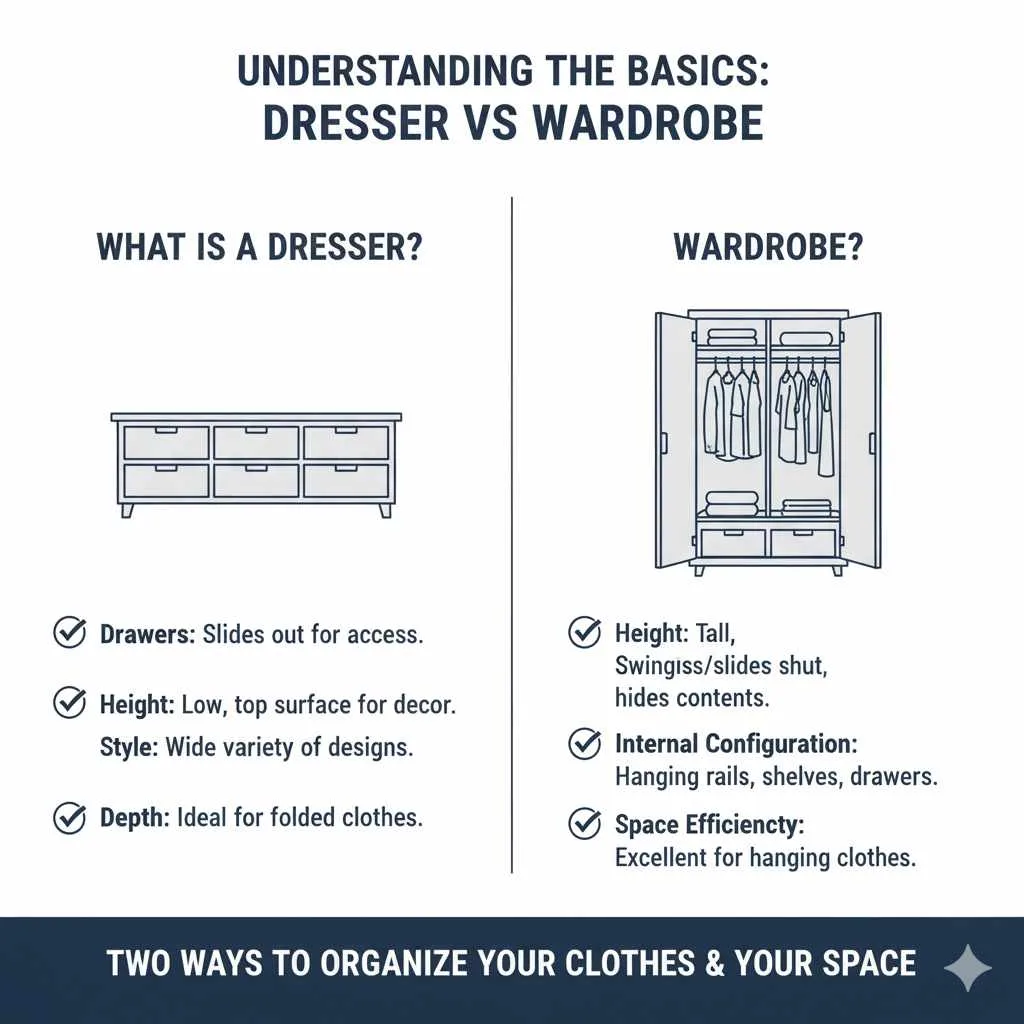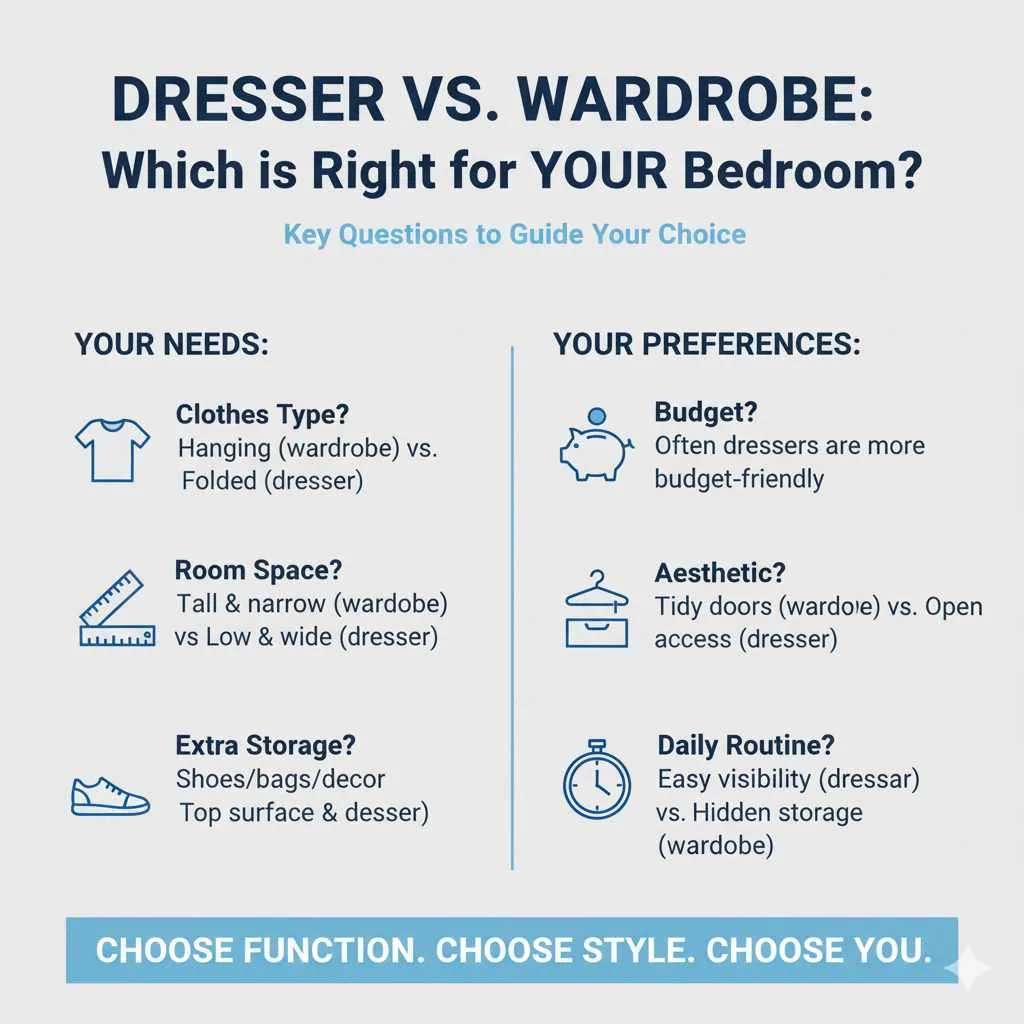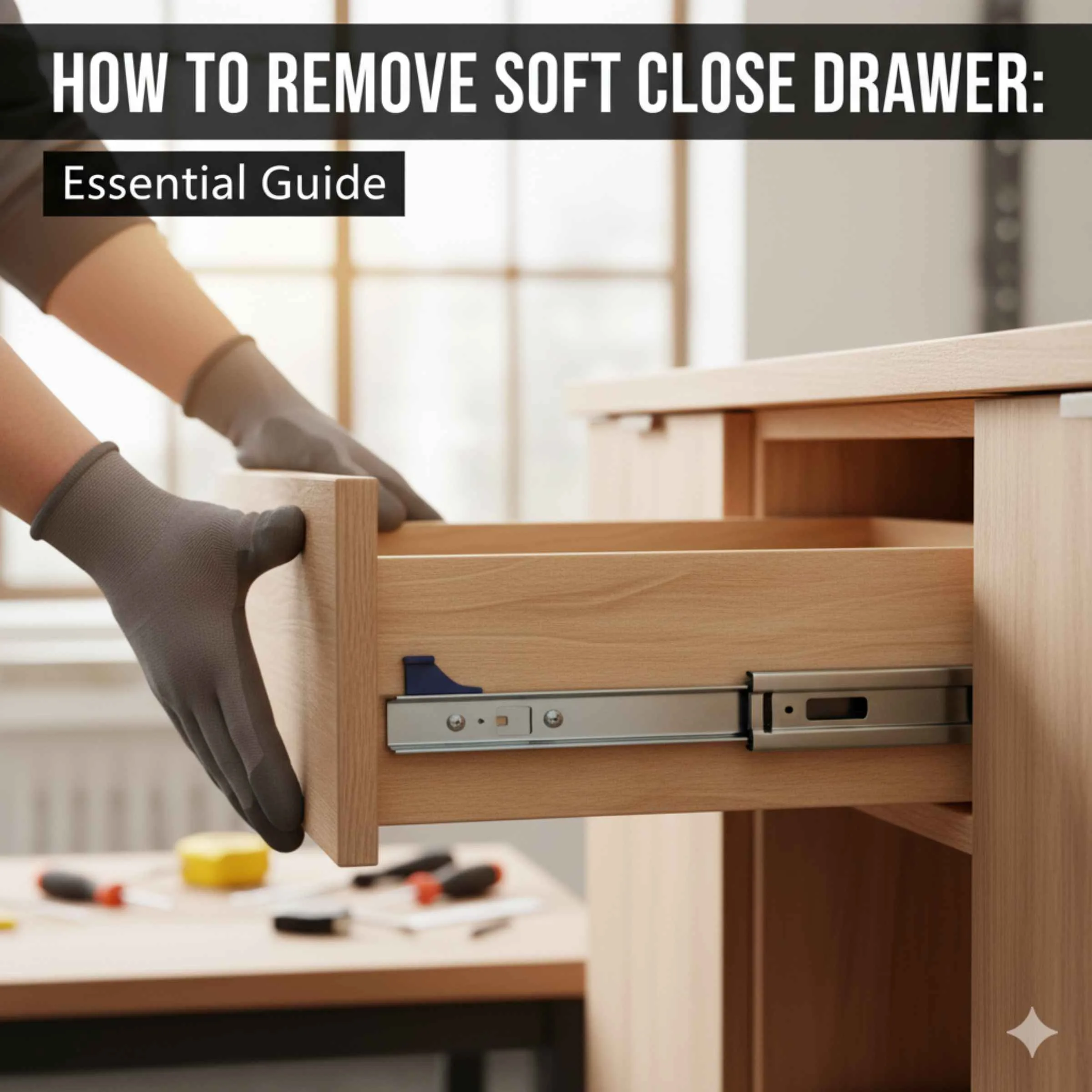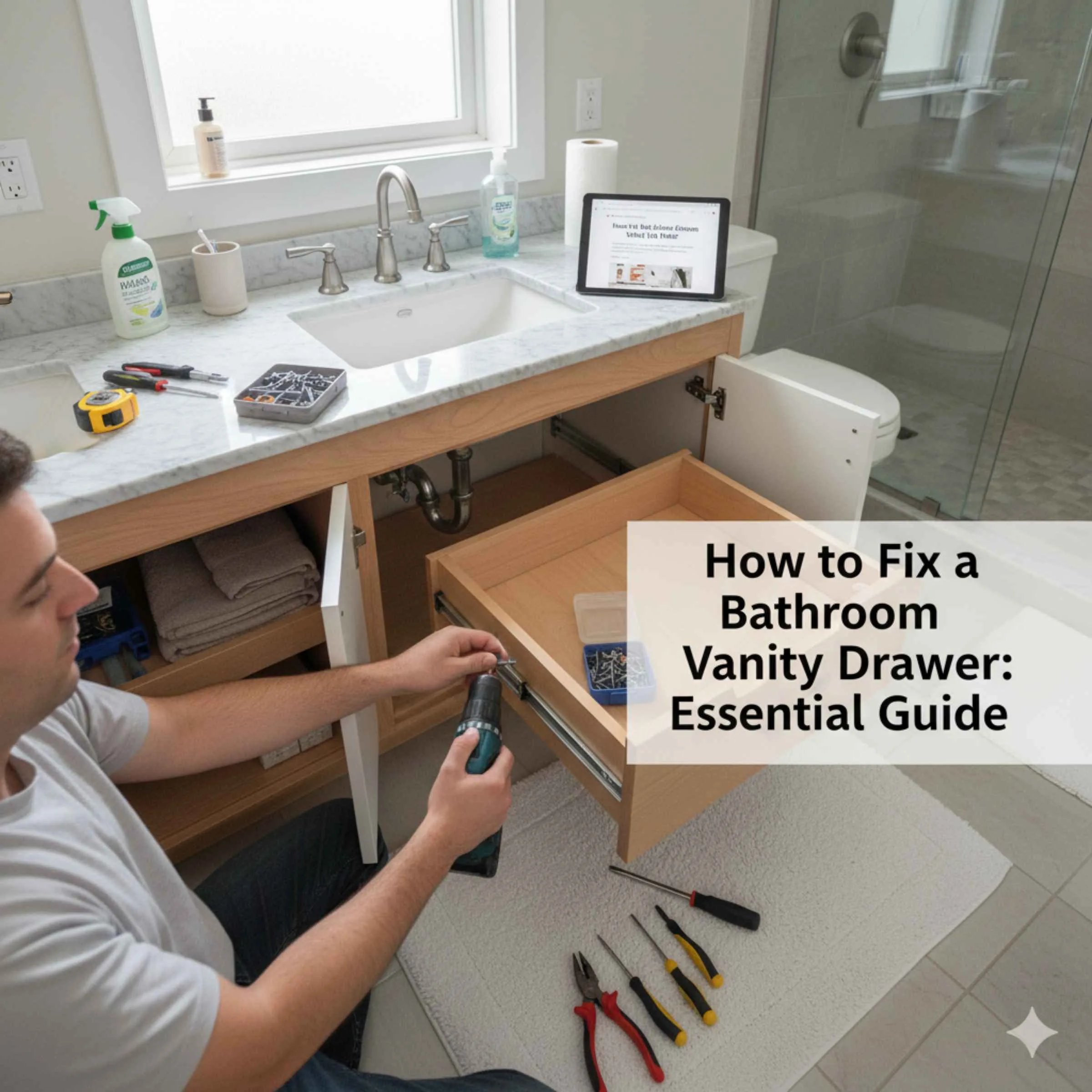Dresser vs Wardrobe: Essential Buying Guide
Quick Summary: A dresser is a low chest of drawers typically for clothing, while a wardrobe is a tall, freestanding closet with doors, shelves, and hanging space. Choose a dresser for smaller items and tighter spaces, and a wardrobe for bulkier clothes and maximum storage. This guide will help you pick the perfect one for your needs!
Choosing the right furniture for your bedroom can feel like a puzzle, especially when it comes to storing your clothes. Two popular options often come up: dressers and wardrobes. But what’s the real difference, and which one is best for you? You might feel a little overwhelmed, and that’s totally okay! It’s a common question for many homeowners and renters trying to make their spaces both stylish and super functional. Don’t worry, though! I’m here to break it all down in a way that’s easy to understand. We’ll look at what each piece offers and how to decide which one will make your bedroom organization dreams come true. Get ready to feel confident about your next furniture purchase!
Understanding the Basics: Dresser vs Wardrobe
Let’s start with the fundamentals. While both dressers and wardrobes are designed to hold your belongings, they do it in very different ways. Thinking about their core features will make choosing much simpler.
What is a Dresser?
A dresser is essentially a low, horizontal chest of drawers. Its primary function is to store folded clothes like t-shirts, sweaters, socks, and underwear. You’ll typically find them in bedrooms, but they can also work well in hallways or living areas for extra storage.
Key Features of a Dresser:
- Drawers: This is the defining characteristic. Drawers slide out, making it easy to see and access your items.
- Height: Dressers are generally shorter than wardrobes, usually reaching waist height or slightly higher. This makes the top surface useful for displaying decorative items, a mirror, or a lamp.
- Style: They come in a vast array of styles, from minimalist modern designs to ornate traditional pieces.
- Depth: The depth of the drawers is ideal for folded garments.
What is a Wardrobe?
A wardrobe, also known as an armoire, is a tall, freestanding closet. Think of it as a miniature, portable closet that you can place anywhere in your room. Its design is much more varied, often incorporating hanging space, shelves, and sometimes drawers.
Key Features of a Wardrobe:
- Height: Wardrobes are tall, reaching from floor to near ceiling in many cases, maximizing vertical storage space.
- Doors: They almost always have doors that swing open or slide shut, hiding the contents and keeping your room looking tidy.
- Internal Configuration: This is where wardrobes really shine. They can have:
- Hanging rails for dresses, shirts, coats, and trousers.
- Shelves for folded items, boxes, or shoes.
- Drawers, though not always present.
- A combination of these.
- Space Efficiency: They are excellent for maximizing storage in a smaller footprint, especially when it comes to hanging clothes.
- Aesthetics: Wardrobes can be statement pieces, adding significant visual interest to a room.

When to Choose a Dresser
A dresser is a fantastic choice when your primary need is for neatly organized, folded clothing, and you have specific space constraints. Its classic design and accessible drawers make it a go-to for many bedrooms.
Ideal Scenarios for a Dresser:
- Storing Folded Clothes: If most of your wardrobe consists of t-shirts, sweaters, jeans, and undergarments that are best folded, a dresser is perfect.
- Space Limitations: In smaller bedrooms or apartments, a lower-profile dresser might fit better than a tall wardrobe, especially if you have low ceilings or limited wall space.
- Bedroom Layout: If you have a walk-in closet for hanging items, a dresser can store the rest of your garments. Or, if you prefer not to have a large piece of furniture dominating your room, a dresser offers a less imposing solution.
- Surface Display: The top of a dresser is valuable real estate. Use it to place a mirror for getting ready, a small lamp for ambient light, or to display your favorite decor items.
- Budget-Friendly Options: Generally, simpler dressers can be more affordable than complex, large wardrobes, making them a great budget-friendly choice for beginners.
Pros and Cons of a Dresser:
| Pros | Cons |
|---|---|
| Excellent for folded items. | Limited hanging space (unless it’s a combined unit). |
| Accessible drawers make finding items easy. | Can become cluttered if not organized. |
| Top surface is useful for decor or mirrors. | May not accommodate long garments like dresses or coats well. |
| Available in many sizes and styles. | Can be heavy and difficult to move once fully loaded. |
| Often more budget-friendly. | May lack the full storage capacity of a wardrobe. |
When to Choose a Wardrobe
A wardrobe is the champion of storage, especially if you have a lot of items that need hanging or if you want to consolidate all your clothing storage into one central piece. It’s a great solution for maximizing space and keeping things neatly tucked away.
Ideal Scenarios for a Wardrobe:
- Ample Hanging Space: If you have many dresses, suits, blouses, or longer items that wrinkle easily, a wardrobe with a hanging rail is essential.
- Maximizing Vertical Space: In rooms with high ceilings or where floor space is at a premium, a tall wardrobe utilizes vertical real estate effectively.
- All-in-One Storage: A well-designed wardrobe can house all your clothing needs – hanging items, folded clothes on shelves, and even shoes or accessories.
- Hiding Clutter: The doors of a wardrobe conceal the contents, helping your bedroom feel more serene and organized.
- Room Aesthetics: A stylish wardrobe can be a focal point in your bedroom, adding architectural interest and a polished look.
Pros and Cons of a Wardrobe:
| Pros | Cons |
|---|---|
| Large storage capacity, especially for hanging items. | Can be bulky and may dominate a smaller room. |
| Keeps clothes hidden and reduces visual clutter. | Internal organization may require additional shelves or boxes. |
| Utilizes vertical space effectively. | Can be difficult to move once assembled. |
| Often comes with multiple storage options (hanging, shelves, drawers). | May require assembly, which can be time-consuming. |
| Can make a strong design statement. | The top surface is usually not usable due to its height. |
Key Factors to Consider When Buying
Now that you know the differences, let’s dive into the practical aspects of choosing the right piece for your home. These factors will help you narrow down your options and make a decision you’ll be happy with.
1. Space and Dimensions
This is arguably the most crucial factor. Measure your room carefully! Note the width, depth, and height of the available space.
- For Dressers: Consider its width for fitting it between windows or alongside other furniture. Ensure there’s enough clearance in front to open the drawers fully.
- For Wardrobes: Measure the wall space where you plan to place it. Crucially, check the ceiling height to ensure it fits. Also, factor in the door swing – will they bump into your bed or another piece of furniture?
The This Old House guide to measuring for furniture is an excellent resource to ensure you don’t miss any details.
2. Storage Needs
Think about what you need to store.
- How many folded items do you have? If it’s the majority of your clothing, a dresser is ideal.
- How many hanging items do you have? If you have lots of shirts, dresses, or suits, a wardrobe with a good hanging rail will be essential.
- Do you need space for shoes, accessories, or bedding? Some wardrobes offer shelves or compartments specifically for these items.
If you have a mix of needs, consider a unit that combines features, like a dresser with a hutch or a wardrobe with built-in drawers. Manufacturers often design pieces with varying internal setups to suit different requirements.
3. Style and Aesthetics
Your furniture should complement your existing decor.
- Modern Minimalist: Look for clean lines, simple hardware, and neutral colors.
- Traditional/Classic: Ornate details, darker wood finishes, and classic silhouettes are key.
- Bohemian/Eclectic: Mix and match styles, perhaps with a vintage dresser or painted wardrobe.
- Scandinavian: Light wood tones, functional design, and a focus on simplicity.
Consider the color and material. Will it blend in or stand out? Do you want a piece that matches your other bedroom furniture, or is it a chance to add a contrasting accent piece?
4. Material and Durability
The materials used will affect the price, durability, and look of your furniture.
- Solid Wood: The most durable and often the most expensive. Oak, maple, and cherry are great choices.
- Engineered Wood (MDF, Particleboard): More affordable and common, especially for mass-produced furniture. Look for good quality construction with sturdy drawer slides and finishes.
- Metal: Often used for industrial-style wardrobes or drawer frames, offering a modern and robust feel.
Check drawer slides! Smoothly operating metal glides are a sign of quality. For wardrobes, ensure the doors operate smoothly and the hinges feel robust.
5. Budget
Furniture prices can vary wildly. Set a budget before you start shopping.
- Basic dressers can be found for under $200.
- Mid-range options typically range from $300 to $800.
- High-end solid wood pieces or designer wardrobes can cost $1,000 or more.
Don’t forget to factor in potential delivery fees or costs for assembly if you’re not doing it yourself. Sometimes, investing a bit more upfront in a well-made piece will save you money in the long run by lasting longer.
6. Assembly Requirements
Will your furniture arrive fully assembled, or will you need to build it?
- Flat-pack furniture is common and budget-friendly but requires assembly. Check the instructions and required tools beforehand. Sites like Family Handyman often have tips for DIY assembly.
- Pre-assembled furniture can be more expensive but saves you time and effort. Be aware that delivery may be more complex for larger, pre-built items.
If assembly seems daunting, look for services that offer in-home assembly with purchase.
Combined Solutions: Dresser-Wardrobe Hybrids
Sometimes, you don’t have to choose just one! Many furniture pieces offer a blend of dresser and wardrobe features, providing a comprehensive storage solution.
What are Hybrid Units?
These are furniture items that combine elements of both dressers and wardrobes. They can be:
- Wardrobes with built-in drawers: These tall units typically have a hanging section and also feature drawers at the bottom, offering both hanging and folded storage in one piece.
- Dressers with hutches or overhead cabinets: A dresser can be topped with a cabinet or open shelving unit, adding vertical storage for items you might otherwise put in a wardrobe.
- Modular storage systems: These systems allow you to mix and match modules – drawers, shelves, hanging rails – to create a custom unit that suits your exact needs, essentially building your own perfect dresser-wardrobe hybrid.
Benefits of Hybrid Solutions:
- Space-saving: Consolidates multiple storage types into one furniture piece.
- Versatile: Caters to a wider range of storage needs.
- Aesthetically pleasing: Creates a cohesive look by combining different storage functions.
- Customizable: Modular systems allow for tailored solutions.
If you find yourself needing both hanging and drawer space, a hybrid unit could be your perfect compromise, offering the best of both worlds without taking up too much extra room.
Dresser vs. Wardrobe: Which is Right for YOUR Bedroom?
To help you solidify your decision, let’s recap by asking yourself a few key questions:
- What kind of clothes do I have most of? Lots of hanging items? Go for a wardrobe. Mostly folded items? A dresser might be enough.
- How much space do I have? A narrow, tall wardrobe could be better than a wide dresser if floor space is limited.
- Do I need storage for more than just clothes? Some wardrobes offer shelves perfect for shoes, bags, or even decorative items.
- What’s my budget? While both have varied price points, simple dressers are often the most budget-friendly entry point.
- What’s my style? Do you prefer the clean lines of drawers or the enclosed, tidy look of doors and internal hanging space?
Think about your daily routine, too. If reaching for clothes easily is a priority, drawers offer great visibility. If you prefer to keep everything out of sight, a wardrobe’s doors are a big plus.

Frequently Asked Questions (FAQ)
Q1: What is the main difference between a dresser and a wardrobe?
A1: The main difference is their form and primary function. A dresser is a low, chest-like piece with drawers for folded clothes. A wardrobe is a tall, freestanding closet with doors, offering hanging space, shelves, and sometimes drawers for a wider variety of clothing and storage needs.
Q2: Can a dresser be used as a wardrobe?
A2: Not in the traditional sense. While you can store clothing in a dresser’s drawers, it lacks the hanging space that defines a wardrobe. You could potentially add a hanging rail to the top of a dresser if it has a hutch, but it won’t replace a true wardrobe for significant hanging storage.
Q3: Can a wardrobe be used as a dresser?
A3: Yes, a wardrobe can serve many of the same functions as a dresser if it includes drawers or shelves for folded items. Many wardrobes are designed with a combination of hanging space and shelf/drawer space, making them very versatile.
Q4: Which is better for a small bedroom: a dresser or a wardrobe?
A4: It depends on your storage needs and room layout. A tall, narrow wardrobe can maximize vertical space in a small room. However, a compact dresser might fit better against a wall and offer accessible drawer storage without overwhelming the space. Measure carefully!
Q5: Do I need both a dresser and a wardrobe?
A5: Many people benefit from having both! A dresser is great for smaller items like socks and underwear and folded t-shirts, while a wardrobe handles dresses, coats, and larger items. However, a single, intelligently designed wardrobe with plenty of shelves and drawers can sometimes suffice on its own.
Q6: What should I look for in a quality dresser or wardrobe?
A6: For dressers, check for sturdy drawer construction, smooth-gliding metal drawer runners, and solid wood or high-quality engineered wood. For wardrobes, ensure robust hinges, well-fitted doors, and sturdy adjustable shelves or good-quality hanging rails. Ample internal storage options are also key.
Conclusion
Deciding between a dresser and a wardrobe doesn’t have to be complicated. By understanding their distinct features and considering your personal storage needs, available space, and style preferences, you can confidently choose the perfect piece for your home.
A dresser is your go-to for neat stacks of folded clothes and a useful top surface, ideal for smaller spaces or complementing existing storage. A wardrobe, on the other hand








Leave a Reply